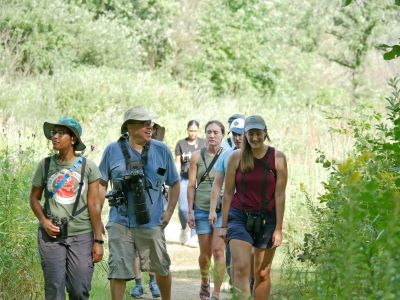Our First Saturday Bird Outings, created as part of our commitment to the Lane Audubon…
Each year American Robins nest on our property. The nesting pairs arrive in late February and begin singing and setting up their territories. One pair of robins nests near our gate, one pair nests across a field to the south, and another nests north of our house, all in conifers. I notice them in the early spring because they are so vocal and aggressive with each other. As trite as it sounds, the robins’ songs are a joy to hear first thing in the morning as well as late in the day. Their vocalizations, along with those of other singing birds of the summer, provide a great morning sound track.
The robins’ nests are made of small twigs, rootlets, and grass that top mud foundations. The nests are well hidden among the branches of the conifers; we can locate them only by observing where the birds fly in. The robin pair works as a team to construct the nest. Sometimes both birds carry in mouthfuls of mud, and sometimes one guards the area while the other builds. Nesting season brings out the robins’ territorial nature. High-speed chases and even physical contact may occur between the pairs if they cross the line into another pair’s territory. They also aggressively defend their nests from animals that may be nest predators—since they are fairly large birds, robins can be intimidating. When the chicks begin to fledge and forage on their own, the adults’ protective nature is obvious. Birds are wonderful parents, guarding and providing food for their vulnerable offspring during this time.
The robins often set up second nests in the late spring or early summer, whether they have succeeded or failed with the first nest of chicks. Usually the second nests are in deciduous trees that have by then leafed out, and the nests are well hidden by the leaves. We have seen both apple trees and oak trees used for second nests. The robins are driven workers throughout their breeding season, which ends in late summer. I find it interesting that they use different trees at different times, showing their adaptability to changes in their habitat. The robins’ ability to find new nest sites within their chosen territory helps them to be a successful species that can live and reproduce in a variety of situations. Although we tend to overlook American Robins because they are so common, it’s worth considering what makes them so common—their remarkable adaptability. It is a pleasure to learn by watching the robins, and I’m happy to have them in my yard, offering up their songs each day.
Note: If you have nesting birds near your home, you might want to participate in NestWatch, a citizen science project organized by the Cornell Lab of Ornithology. For more information, go to http://nestwatch.org/.



